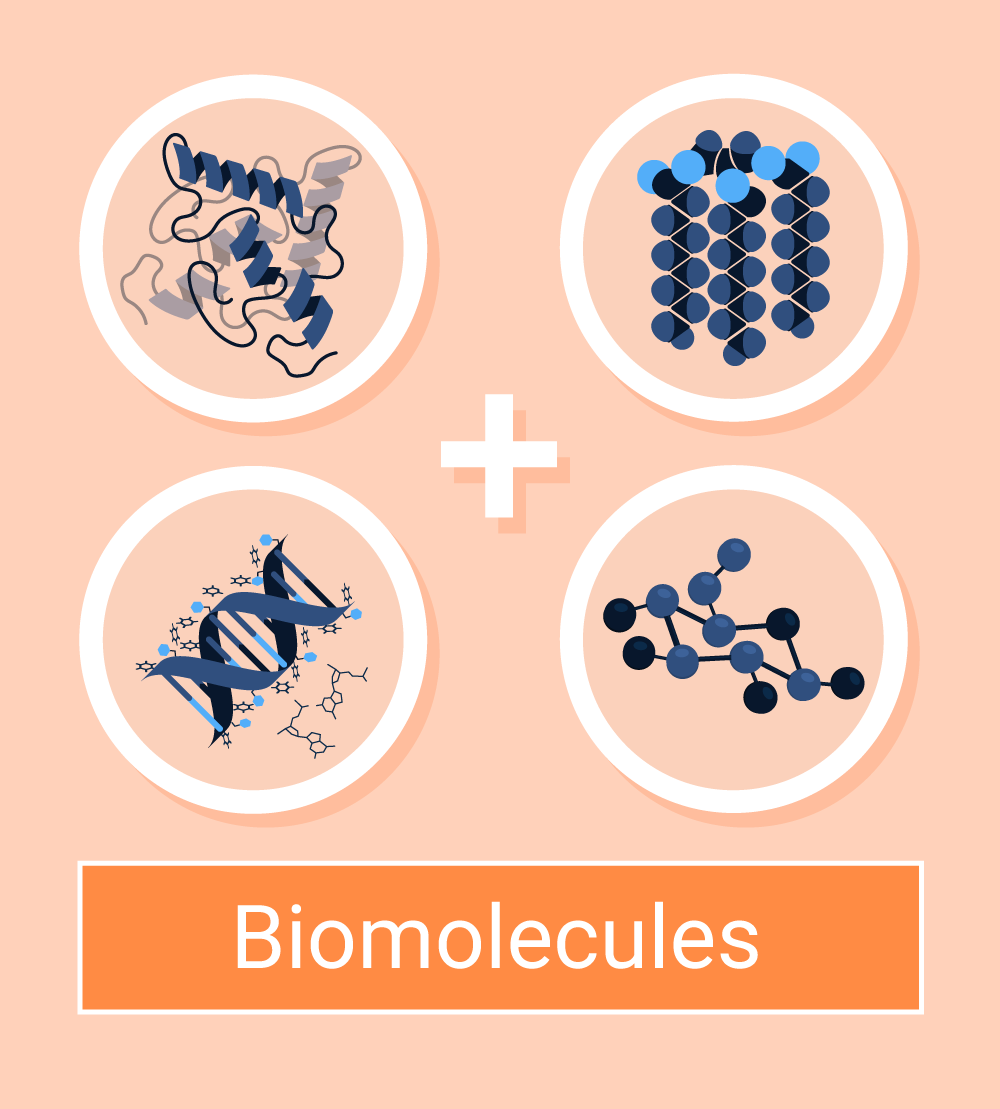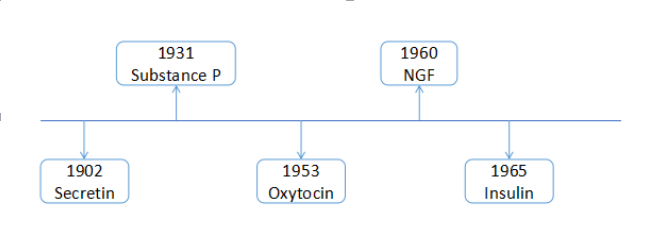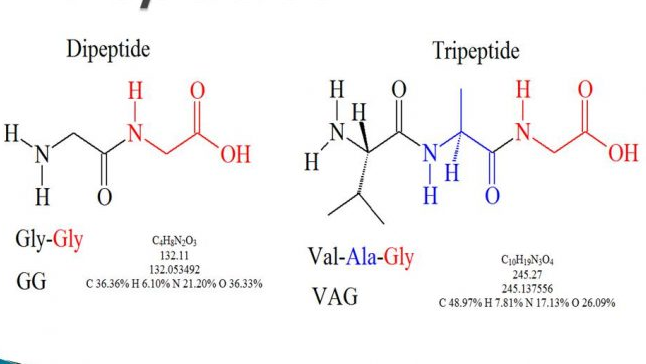

The biological significance of proteins was recognized more than two centuries ago.[1] They were considered the primary material required for living organisms. But from the beginning of the 20th century, the significance of protein-like molecules, peptides, became apparent in several life processes.[1]

Figure: The illustration of name and year of peptides discovered in the 20th century.
Source: Creative Peptides[2]
Like proteins, peptides also consist of chains of amino acids and are held together by peptide bonds. Peptides have the same properties as protein molecules.[2] However, unlike proteins, their classes of molecules are small, simpler, and of lower molecular weight. They consist of 2-50 amino acids, unlike proteins which consist of more than 50 amino acids.[2]
Emil Fischer is considered the father of the chemistry of peptides. He coined the term “peptide,” which originated from the word “pepsis,” meaning digestion products of proteins.[1]
This article poses a classification of peptides, their classes, actions, and essential peptide functions in living organisms.
Peptides are formed by linking two or more amino acids through an amide linkage, called a peptide bond.[3] The formation of peptide bonds occurs by the removal of a hydroxyl group (-OH) from one alpha-amino group and hydrogen (-H) atom from another alpha-amino group, forming a water molecule (H2O). This reaction is called a dehydration reaction.[3]
Peptides are sub-categorized into two groups based on the number of amino acids present in their structures: oligopeptides and polypeptides.[3]
When two or more (but less than 20) amino acids are linked together with the loss of a water molecule, they are called oligopeptides. It also includes dipeptides, tripeptides, tetrapeptides, and pentapeptides. Some examples of naturally occurring oligopeptides are microviridin, cyanopeptolin, microcystins, etc.[4]

Figure: An illustrative structure of dipeptide and tripeptide.
Source: Online Biology notes.[3]
The oligopeptides are synthesized through non-ribosomal pathways, except for cyclamates and microviridin synthesized through ribosomal pathways.[4] There are several ways to identify peptides, and these ways include gel chromatography, HPLC, HPLC-mass spectroscopy, and ion-exchange chromatography.[4]
When 20 or more amino acids are linked together through covalent peptide bonds, they are called polypeptides.[4] One or more polypeptides are involved in the formation of proteins. They have two terminals present in their structure: N-terminal containing an amino group and C-terminal containing a carboxyl group. Some examples of polypeptides include insulin and growth hormones.[4]
Polypeptides are arranged in different structural forms to create different functional proteins. So, according to the number and arrangement of polypeptides, the structure of proteins are categorized into four groups:[4]
Peptides, based on their functional properties, are categorized into many small groups. Here’s a list of the most commonly studied classes of peptides in organisms, along with their functions and some examples.[5]
Antimicrobial peptides, also known as host defense peptides, are a class of peptides that play a role in the innate immune response of all organisms.[6] They are classified into two groups: ribosomally synthesized peptides and non-ribosomally synthesized peptides.[6]
As the name suggests, bacterial peptides are fragments of proteins produced by bacteria. They include flagellar peptides, lipoproteins, enterotoxins, and several enzymes.[7]
The peptides secreted from both gram-positive and gram-negative bacteria are both cationic and neutral.[6] These types of peptides are included within bacteriocin that kills specific competitor bacteria, protecting the host bacterium.[6]
Examples include Escherichia coli 7-amino-acid peptide microcin C7 (inhibits protein synthesis), Lactococcus peptide mersacidin (inhibits peptidoglycan biosynthesis), nisin, and epidermin (permeabilizes target cell membrane).[6]
These are small proteins synthesized by neurons to act on receptors and modulate synaptic transmission.[8] The neuropeptides are synthesized by large, inactive precursor proteins, called pre-propeptides.
These proteins are cleaved into several active peptides and produce multiple copies of different neuropeptides.[8] Most neuropeptides act on G protein-coupled receptors (GPCRs) and fall into two families: the rhodopsin-like and the secretin families.
Examples include acetylcholine, epinephrine, norepinephrine, dopamine, serotonin, and Gamma-aminobutyric acid (GABA).[8]
Anticancer peptides (ACPs) are small peptides with a short amino acid sequence that are selective and toxic to cancer cells.[9] The predominant amino acids in anticancer peptides include glycine, lysine, and leucine.[9]
The anticancer peptides are a highly preferred choice among all the other available anticancer therapeutics due to their high selectivity, high penetration, and easy modifications.[9]
The peptides destroy cancer cells via apoptosis and necrosis by lysing or forming pores in the membranes of cancerous cells. These types of peptides, depending on their structure, mode of action, selectivity, and efficacy to specific cancer cells, are divided into three categories:[9]
They are short amino acid-chained peptide hormones synthesized and secreted by specialized cells in the endocrine.[11] They are stored in membrane-bound secretory vesicles, which enable their rapid secretion whenever required.
They are water-soluble, and this makes it difficult for them to cross the hydrophobic cell membranes.[11] Thus, they need specific receptors on the cell surface to exert their actions.
Some examples of endocrine peptides include:
The endogenous and exogenous opioids exert several physiological and pharmacological effects through receptors of four different subtypes.[12] It include μ (μ1, μ2), 𝜹 (𝜹1, 𝜹2), 𝜿 (𝜿1, 𝜿2), and ε (ε1, ε2).[12]
They regulate other endocrine systems like the hypothalamic-pituitary-adrenocortical axis and the phenomenon of stress-induced analgesia.[12]
Endogenous opiate peptides are better studied than exogenous peptides. They consist of three families of peptides based on their origin:[12]
Some peptides like cholecystokinin (CCK), neuropeptide FF (NPFF), and melanocyte inhibiting factor (MIF)-related peptides possess anti-opioid properties.[12] But these peptide families also include some peptides harboring opioid-like properties, and that’s why they are also known as “opioid modulating” peptides.[12]
Plant peptides are peptides that originated in plants and they possess significant health benefits in humans. They lower blood pressure and cholesterol levels and inhibit enzymes within the renin-angiotensin-aldosterone system (RAAS).
Other benefits include their anti-inflammatory activity, anticancer and immunomodulatory activities, prevention of and protection against oxidative damage through free radical scavenging activities, and antimicrobial activity.[13]
Plant peptides are categorized into three groups based on their functional response:[13]
Toxins developed in animals are strategies to protect themselves from different predators and/or capture their prey.[14]
Several of these venoms studied are found in animals with envenomation apparatus like cone snails, spiders, scorpions, snakes, the Gila monster lizard, and sea anemone.[14]
Venom peptides act as natural ligands of ions channels and different receptors they bind to initiate physiological responses.[14] Based on these characteristics, they are categorized into eight groups:[14]
The application of these peptides in healthcare sectors demands many issues associated with their safety, pharmacokinetics, and delivery to be addressed.[13]
Peptides are a class of biological molecules that have essential roles in fundamental physiological processes and are required for many biochemical processes. They are small molecules made by sequential arrangements of 2-50 amino acids. The difference between peptide and protein is that proteins are large chains of amino acid sequence (50 or more) with different specialized structures.
The benefits of peptides have established a special place in the pharmaceutical landscape.[15] And the innovations in peptide therapeutics are believed to rise in the future by expanding into new indications and molecular targets, exploiting novel chemistry strategies to broaden molecular diversity, and engineering enhanced pharmaceutical properties.[15]
Further, the study of peptide benefits and chemistry opens a door for scientists to unravel its hidden potentials. It can be identifying novel targets and receptors of peptides, the discovery of more peptides in organisms and their functional properties, or the discovery of sustainable peptide-based drugs.[15]
In behavioral neuroscience, the Open Field Test (OFT) remains one of the most widely used assays to evaluate rodent models of affect, cognition, and motivation. It provides a non-invasive framework for examining how animals respond to novelty, stress, and pharmacological or environmental manipulations. Among the test’s core metrics, the percentage of time spent in the center zone offers a uniquely normalized and sensitive measure of an animal’s emotional reactivity and willingness to engage with a potentially risky environment.
This metric is calculated as the proportion of time spent in the central area of the arena—typically the inner 25%—relative to the entire session duration. By normalizing this value, researchers gain a behaviorally informative variable that is resilient to fluctuations in session length or overall movement levels. This makes it especially valuable in comparative analyses, longitudinal monitoring, and cross-model validation.
Unlike raw center duration, which can be affected by trial design inconsistencies, the percentage-based measure enables clearer comparisons across animals, treatments, and conditions. It plays a key role in identifying trait anxiety, avoidance behavior, risk-taking tendencies, and environmental adaptation, making it indispensable in both basic and translational research contexts.
Whereas simple center duration provides absolute time, the percentage-based metric introduces greater interpretability and reproducibility, especially when comparing different animal models, treatment conditions, or experimental setups. It is particularly effective for quantifying avoidance behaviors, risk assessment strategies, and trait anxiety profiles in both acute and longitudinal designs.
This metric reflects the relative amount of time an animal chooses to spend in the open, exposed portion of the arena—typically defined as the inner 25% of a square or circular enclosure. Because rodents innately prefer the periphery (thigmotaxis), time in the center is inversely associated with anxiety-like behavior. As such, this percentage is considered a sensitive, normalized index of:
Critically, because this metric is normalized by session duration, it accommodates variability in activity levels or testing conditions. This makes it especially suitable for comparing across individuals, treatment groups, or timepoints in longitudinal studies.
A high percentage of center time indicates reduced anxiety, increased novelty-seeking, or pharmacological modulation (e.g., anxiolysis). Conversely, a low percentage suggests emotional inhibition, behavioral avoidance, or contextual hypervigilance. reduced anxiety, increased novelty-seeking, or pharmacological modulation (e.g., anxiolysis). Conversely, a low percentage suggests emotional inhibition, behavioral avoidance, or contextual hypervigilance.
The percentage of center time is one of the most direct, unconditioned readouts of anxiety-like behavior in rodents. It is frequently reduced in models of PTSD, chronic stress, or early-life adversity, where animals exhibit persistent avoidance of the center due to heightened emotional reactivity. This metric can also distinguish between acute anxiety responses and enduring trait anxiety, especially in longitudinal or developmental studies. Its normalized nature makes it ideal for comparing across cohorts with variable locomotor profiles, helping researchers detect true affective changes rather than activity-based confounds.
Rodents that spend more time in the center zone typically exhibit broader and more flexible exploration strategies. This behavior reflects not only reduced anxiety but also cognitive engagement and environmental curiosity. High center percentage is associated with robust spatial learning, attentional scanning, and memory encoding functions, supported by coordinated activation in the prefrontal cortex, hippocampus, and basal forebrain. In contrast, reduced center engagement may signal spatial rigidity, attentional narrowing, or cognitive withdrawal, particularly in models of neurodegeneration or aging.
The open field test remains one of the most widely accepted platforms for testing anxiolytic and psychotropic drugs. The percentage of center time reliably increases following administration of anxiolytic agents such as benzodiazepines, SSRIs, and GABA-A receptor agonists. This metric serves as a sensitive and reproducible endpoint in preclinical dose-finding studies, mechanistic pharmacology, and compound screening pipelines. It also aids in differentiating true anxiolytic effects from sedation or motor suppression by integrating with other behavioral parameters like distance traveled and entry count (Prut & Belzung, 2003).
Sex-based differences in emotional regulation often manifest in open field behavior, with female rodents generally exhibiting higher variability in center zone metrics due to hormonal cycling. For example, estrogen has been shown to facilitate exploratory behavior and increase center occupancy, while progesterone and stress-induced corticosterone often reduce it. Studies involving gonadectomy, hormone replacement, or sex-specific genetic knockouts use this metric to quantify the impact of endocrine factors on anxiety and exploratory behavior. As such, it remains a vital tool for dissecting sex-dependent neurobehavioral dynamics.
The percentage of center time is one of the most direct, unconditioned readouts of anxiety-like behavior in rodents. It is frequently reduced in models of PTSD, chronic stress, or early-life adversity. Because it is normalized, this metric is especially helpful for distinguishing between genuine avoidance and low general activity.
Environmental Control: Uniformity in environmental conditions is essential. Lighting should be evenly diffused to avoid shadow bias, and noise should be minimized to prevent stress-induced variability. The arena must be cleaned between trials using odor-neutral solutions to eliminate scent trails or pheromone cues that may affect zone preference. Any variation in these conditions can introduce systematic bias in center zone behavior. Use consistent definitions of the center zone (commonly 25% of total area) to allow valid comparisons. Software-based segmentation enhances spatial precision.
Evaluating how center time evolves across the duration of a session—divided into early, middle, and late thirds—provides insight into behavioral transitions and adaptive responses. Animals may begin by avoiding the center, only to gradually increase center time as they habituate to the environment. Conversely, persistently low center time across the session can signal prolonged anxiety, fear generalization, or a trait-like avoidance phenotype.
To validate the significance of center time percentage, it should be examined alongside results from other anxiety-related tests such as the Elevated Plus Maze, Light-Dark Box, or Novelty Suppressed Feeding. Concordance across paradigms supports the reliability of center time as a trait marker, while discordance may indicate task-specific reactivity or behavioral dissociation.
When paired with high-resolution scoring of behavioral events such as rearing, grooming, defecation, or immobility, center time offers a richer view of the animal’s internal state. For example, an animal that spends substantial time in the center while grooming may be coping with mild stress, while another that remains immobile in the periphery may be experiencing more severe anxiety. Microstructure analysis aids in decoding the complexity behind spatial behavior.
Animals naturally vary in their exploratory style. By analyzing percentage of center time across subjects, researchers can identify behavioral subgroups—such as consistently bold individuals who frequently explore the center versus cautious animals that remain along the periphery. These classifications can be used to examine predictors of drug response, resilience to stress, or vulnerability to neuropsychiatric disorders.
In studies with large cohorts or multiple behavioral variables, machine learning techniques such as hierarchical clustering or principal component analysis can incorporate center time percentage to discover novel phenotypic groupings. These data-driven approaches help uncover latent dimensions of behavior that may not be visible through univariate analyses alone.
Total locomotion helps contextualize center time. Low percentage values in animals with minimal movement may reflect sedation or fatigue, while similar values in high-mobility subjects suggest deliberate avoidance. This metric helps distinguish emotional versus motor causes of low center engagement.
This measure indicates how often the animal initiates exploration of the center zone. When combined with percentage of time, it differentiates between frequent but brief visits (indicative of anxiety or impulsivity) versus fewer but sustained center engagements (suggesting comfort and behavioral confidence).
The delay before the first center entry reflects initial threat appraisal. Longer latencies may be associated with heightened fear or low motivation, while shorter latencies are typically linked to exploratory drive or low anxiety.
Time spent hugging the walls offers a spatial counterbalance to center metrics. High thigmotaxis and low center time jointly support an interpretation of strong avoidance behavior. This inverse relationship helps triangulate affective and motivational states.
By expressing center zone activity as a proportion of total trial time, researchers gain a metric that is resistant to session variability and more readily comparable across time, treatment, and model conditions. This normalized measure enhances reproducibility and statistical power, particularly in multi-cohort or cross-laboratory designs.
For experimental designs aimed at assessing anxiety, exploratory strategy, or affective state, the percentage of time spent in the center offers one of the most robust and interpretable measures available in the Open Field Test.
Written by researchers, for researchers — powered by Conduct Science.








Monday – Friday
9 AM – 5 PM EST
DISCLAIMER: ConductScience and affiliate products are NOT designed for human consumption, testing, or clinical utilization. They are designed for pre-clinical utilization only. Customers purchasing apparatus for the purposes of scientific research or veterinary care affirm adherence to applicable regulatory bodies for the country in which their research or care is conducted.